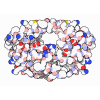+ Open data
Open data
- Basic information
Basic information
| Entry | Database: PDB / ID: 5t6w | ||||||
|---|---|---|---|---|---|---|---|
| Title | HLA-B*57:01 presenting SSTRGISQLW | ||||||
 Components Components |
| ||||||
 Keywords Keywords | IMMUNE SYSTEM / human leukocyte antigen Immunoglobulin domain antigen presentation | ||||||
| Function / homology |  Function and homology information Function and homology informationNuclear Pore Complex (NPC) Disassembly / Regulation of Glucokinase by Glucokinase Regulatory Protein / Defective TPR may confer susceptibility towards thyroid papillary carcinoma (TPC) / Transport of Ribonucleoproteins into the Host Nucleus / Transport of the SLBP independent Mature mRNA / Transport of the SLBP Dependant Mature mRNA / NS1 Mediated Effects on Host Pathways / regulation of interleukin-12 production / SUMOylation of SUMOylation proteins / regulation of dendritic cell differentiation ...Nuclear Pore Complex (NPC) Disassembly / Regulation of Glucokinase by Glucokinase Regulatory Protein / Defective TPR may confer susceptibility towards thyroid papillary carcinoma (TPC) / Transport of Ribonucleoproteins into the Host Nucleus / Transport of the SLBP independent Mature mRNA / Transport of the SLBP Dependant Mature mRNA / NS1 Mediated Effects on Host Pathways / regulation of interleukin-12 production / SUMOylation of SUMOylation proteins / regulation of dendritic cell differentiation / nuclear localization sequence binding / structural constituent of nuclear pore / Transport of Mature mRNA Derived from an Intronless Transcript / Rev-mediated nuclear export of HIV RNA / regulation of T cell anergy / Nuclear import of Rev protein / SUMOylation of RNA binding proteins / NEP/NS2 Interacts with the Cellular Export Machinery / regulation of interleukin-6 production / RNA export from nucleus / Transport of Mature mRNA derived from an Intron-Containing Transcript / tRNA processing in the nucleus / Postmitotic nuclear pore complex (NPC) reformation / nucleocytoplasmic transport / Viral Messenger RNA Synthesis / SUMOylation of ubiquitinylation proteins / Vpr-mediated nuclear import of PICs / TAP binding / protection from natural killer cell mediated cytotoxicity / SUMOylation of DNA replication proteins / antigen processing and presentation of endogenous peptide antigen via MHC class I via ER pathway, TAP-independent / antigen processing and presentation of endogenous peptide antigen via MHC class Ib / Regulation of HSF1-mediated heat shock response / mRNA transport / detection of bacterium / nuclear pore / SUMOylation of DNA damage response and repair proteins / secretory granule membrane / negative regulation of receptor binding / early endosome lumen / SUMOylation of chromatin organization proteins / Nef mediated downregulation of MHC class I complex cell surface expression / DAP12 interactions / transferrin transport / HCMV Late Events / cellular response to iron ion / lumenal side of endoplasmic reticulum membrane / Endosomal/Vacuolar pathway / Antigen Presentation: Folding, assembly and peptide loading of class I MHC / peptide antigen assembly with MHC class II protein complex / cellular response to iron(III) ion / MHC class II protein complex / negative regulation of forebrain neuron differentiation / antigen processing and presentation of exogenous protein antigen via MHC class Ib, TAP-dependent / ER to Golgi transport vesicle membrane / Transcriptional regulation by small RNAs / peptide antigen assembly with MHC class I protein complex / regulation of iron ion transport / regulation of erythrocyte differentiation / HFE-transferrin receptor complex / response to molecule of bacterial origin / MHC class I peptide loading complex / defense response / T cell mediated cytotoxicity / positive regulation of T cell cytokine production / antigen processing and presentation of endogenous peptide antigen via MHC class I / antigen processing and presentation of exogenous peptide antigen via MHC class II / positive regulation of immune response / MHC class I protein complex / positive regulation of T cell activation / peptide antigen binding / positive regulation of receptor-mediated endocytosis / negative regulation of neurogenesis / cellular response to nicotine / positive regulation of T cell mediated cytotoxicity / multicellular organismal-level iron ion homeostasis / ISG15 antiviral mechanism / specific granule lumen / phagocytic vesicle membrane / recycling endosome membrane / Interferon gamma signaling / Immunoregulatory interactions between a Lymphoid and a non-Lymphoid cell / negative regulation of epithelial cell proliferation / protein import into nucleus / HCMV Early Events / MHC class II protein complex binding / Interferon alpha/beta signaling / Modulation by Mtb of host immune system / late endosome membrane / sensory perception of smell / positive regulation of cellular senescence / tertiary granule lumen / nuclear envelope / DAP12 signaling / T cell differentiation in thymus / negative regulation of neuron projection development / protein-folding chaperone binding / ER-Phagosome pathway / protein refolding / snRNP Assembly Similarity search - Function | ||||||
| Biological species |  Homo sapiens (human) Homo sapiens (human)synthetic construct (others) | ||||||
| Method |  X-RAY DIFFRACTION / X-RAY DIFFRACTION /  SYNCHROTRON / SYNCHROTRON /  MOLECULAR REPLACEMENT / Resolution: 1.9 Å MOLECULAR REPLACEMENT / Resolution: 1.9 Å | ||||||
 Authors Authors | Pymm, P. / Rossjohn, J. / Vivian, J.P. | ||||||
 Citation Citation |  Journal: Nat. Struct. Mol. Biol. / Year: 2017 Journal: Nat. Struct. Mol. Biol. / Year: 2017Title: MHC-I peptides get out of the groove and enable a novel mechanism of HIV-1 escape. Authors: Pymm, P. / Illing, P.T. / Ramarathinam, S.H. / O'Connor, G.M. / Hughes, V.A. / Hitchen, C. / Price, D.A. / Ho, B.K. / McVicar, D.W. / Brooks, A.G. / Purcell, A.W. / Rossjohn, J. / Vivian, J.P. | ||||||
| History |
|
- Structure visualization
Structure visualization
| Structure viewer | Molecule:  Molmil Molmil Jmol/JSmol Jmol/JSmol |
|---|
- Downloads & links
Downloads & links
- Download
Download
| PDBx/mmCIF format |  5t6w.cif.gz 5t6w.cif.gz | 178.3 KB | Display |  PDBx/mmCIF format PDBx/mmCIF format |
|---|---|---|---|---|
| PDB format |  pdb5t6w.ent.gz pdb5t6w.ent.gz | 140.2 KB | Display |  PDB format PDB format |
| PDBx/mmJSON format |  5t6w.json.gz 5t6w.json.gz | Tree view |  PDBx/mmJSON format PDBx/mmJSON format | |
| Others |  Other downloads Other downloads |
-Validation report
| Summary document |  5t6w_validation.pdf.gz 5t6w_validation.pdf.gz | 450 KB | Display |  wwPDB validaton report wwPDB validaton report |
|---|---|---|---|---|
| Full document |  5t6w_full_validation.pdf.gz 5t6w_full_validation.pdf.gz | 453.3 KB | Display | |
| Data in XML |  5t6w_validation.xml.gz 5t6w_validation.xml.gz | 17.9 KB | Display | |
| Data in CIF |  5t6w_validation.cif.gz 5t6w_validation.cif.gz | 25.4 KB | Display | |
| Arichive directory |  https://data.pdbj.org/pub/pdb/validation_reports/t6/5t6w https://data.pdbj.org/pub/pdb/validation_reports/t6/5t6w ftp://data.pdbj.org/pub/pdb/validation_reports/t6/5t6w ftp://data.pdbj.org/pub/pdb/validation_reports/t6/5t6w | HTTPS FTP |
-Related structure data
| Related structure data |  5t6xC  5t6yC  5t6zC  5t70C  2rfxS C: citing same article ( S: Starting model for refinement |
|---|---|
| Similar structure data |
- Links
Links
- Assembly
Assembly
| Deposited unit | 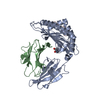
| ||||||||
|---|---|---|---|---|---|---|---|---|---|
| 1 |
| ||||||||
| Unit cell |
|
- Components
Components
| #1: Protein | Mass: 31736.172 Da / Num. of mol.: 1 / Fragment: UNP residues 25-300 Source method: isolated from a genetically manipulated source Source: (gene. exp.)  Homo sapiens (human) / Gene: HLA-B, HLAB / Plasmid: pET-30 / Production host: Homo sapiens (human) / Gene: HLA-B, HLAB / Plasmid: pET-30 / Production host:  |
|---|---|
| #2: Protein | Mass: 11748.160 Da / Num. of mol.: 1 / Fragment: UNP residues 21-119 Source method: isolated from a genetically manipulated source Source: (gene. exp.)  Homo sapiens (human) / Gene: B2M, CDABP0092, HDCMA22P / Plasmid: pET-30 / Production host: Homo sapiens (human) / Gene: B2M, CDABP0092, HDCMA22P / Plasmid: pET-30 / Production host:  |
| #3: Protein/peptide | Mass: 1135.252 Da / Num. of mol.: 1 / Source method: obtained synthetically / Source: (synth.) synthetic construct (others) / References: UniProt: Q96HA1*PLUS |
| #4: Chemical | ChemComp-GOL / |
| #5: Water | ChemComp-HOH / |
| Has protein modification | Y |
-Experimental details
-Experiment
| Experiment | Method:  X-RAY DIFFRACTION / Number of used crystals: 1 X-RAY DIFFRACTION / Number of used crystals: 1 |
|---|
- Sample preparation
Sample preparation
| Crystal | Density Matthews: 2.54 Å3/Da / Density % sol: 51.61 % |
|---|---|
| Crystal grow | Temperature: 298 K / Method: vapor diffusion, hanging drop / pH: 5.6 Details: 12 -20 % PEG 4000, 0.2 M ammonium acetate and 0.1 M tri-sodium citrate pH 5.6 |
-Data collection
| Diffraction | Mean temperature: 100 K |
|---|---|
| Diffraction source | Source:  SYNCHROTRON / Site: SYNCHROTRON / Site:  Australian Synchrotron Australian Synchrotron  / Beamline: MX2 / Wavelength: 0.954 Å / Beamline: MX2 / Wavelength: 0.954 Å |
| Detector | Type: ADSC QUANTUM 315 / Detector: CCD / Date: Apr 12, 2015 |
| Radiation | Protocol: SINGLE WAVELENGTH / Monochromatic (M) / Laue (L): M / Scattering type: x-ray |
| Radiation wavelength | Wavelength: 0.954 Å / Relative weight: 1 |
| Reflection | Resolution: 1.9→32.637 Å / Num. obs: 36411 / % possible obs: 99.6 % / Redundancy: 3.9 % / Rmerge(I) obs: 0.197 / Net I/σ(I): 4.7 |
| Reflection shell | Resolution: 1.9→2 Å / Redundancy: 3.9 % / Rmerge(I) obs: 0.553 / Mean I/σ(I) obs: 2.3 / % possible all: 99.8 |
- Processing
Processing
| Software |
| ||||||||||||||||||||||||||||||||||||||||||||||||||||||||||||||||||||||||||||||||||||||||||||||||||
|---|---|---|---|---|---|---|---|---|---|---|---|---|---|---|---|---|---|---|---|---|---|---|---|---|---|---|---|---|---|---|---|---|---|---|---|---|---|---|---|---|---|---|---|---|---|---|---|---|---|---|---|---|---|---|---|---|---|---|---|---|---|---|---|---|---|---|---|---|---|---|---|---|---|---|---|---|---|---|---|---|---|---|---|---|---|---|---|---|---|---|---|---|---|---|---|---|---|---|---|
| Refinement | Method to determine structure:  MOLECULAR REPLACEMENT MOLECULAR REPLACEMENTStarting model: 2RFX Resolution: 1.9→32.637 Å / SU ML: 0.3 / Cross valid method: THROUGHOUT / σ(F): 1.35 / Phase error: 28.65
| ||||||||||||||||||||||||||||||||||||||||||||||||||||||||||||||||||||||||||||||||||||||||||||||||||
| Solvent computation | Shrinkage radii: 0.9 Å / VDW probe radii: 1.11 Å | ||||||||||||||||||||||||||||||||||||||||||||||||||||||||||||||||||||||||||||||||||||||||||||||||||
| Refinement step | Cycle: LAST / Resolution: 1.9→32.637 Å
| ||||||||||||||||||||||||||||||||||||||||||||||||||||||||||||||||||||||||||||||||||||||||||||||||||
| Refine LS restraints |
| ||||||||||||||||||||||||||||||||||||||||||||||||||||||||||||||||||||||||||||||||||||||||||||||||||
| LS refinement shell |
| ||||||||||||||||||||||||||||||||||||||||||||||||||||||||||||||||||||||||||||||||||||||||||||||||||
| Refinement TLS params. | Method: refined / Origin x: -12.3275 Å / Origin y: 9.1785 Å / Origin z: -18.4472 Å
| ||||||||||||||||||||||||||||||||||||||||||||||||||||||||||||||||||||||||||||||||||||||||||||||||||
| Refinement TLS group | Selection details: all |
 Movie
Movie Controller
Controller



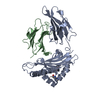
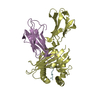

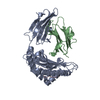
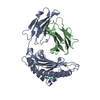

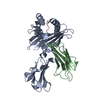

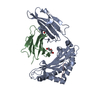
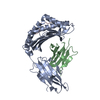

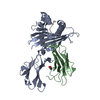

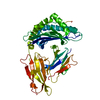
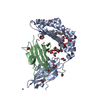
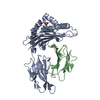
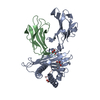



 PDBj
PDBj












